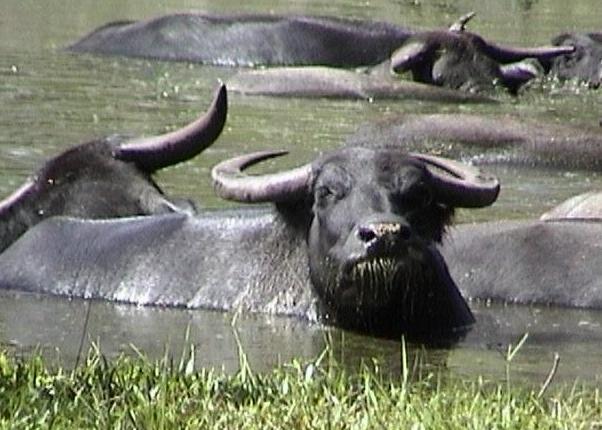|
Kaibauk
''Some of this article is translated from the existing German Wikipedia article at :de:Kaibauk; see its history for attribution.'' The Kaibauk is a type of headdress worn by the Timorese liurai. Traditionally made of silver, it is shaped like the horns of a water buffalo. Symbolism The buffalo horns are a widely used symbol in the cultures of Timor-Leste Timor-Leste, also known as East Timor, officially the Democratic Republic of Timor-Leste, is a country in Southeast Asia. It comprises the eastern half of the island of Timor, the coastal exclave of Oecusse in the island's northwest, and ..., both on the Kaibauk and on the roofs of traditional sacred houses (''uma lulik'' in Tetun). They represent strength, security and protection. The counterpart to the Kaibauk is the Belak, a round bronze disc that is worn on the chest. It represents the moon and symbolises peace, prosperity and fertility. Kaibauk and Belak are meant to complement each other, their combinati ... [...More Info...] [...Related Items...] OR: [Wikipedia] [Google] [Baidu] |
Timor-Leste
Timor-Leste, also known as East Timor, officially the Democratic Republic of Timor-Leste, is a country in Southeast Asia. It comprises the eastern half of the island of Timor, the coastal exclave of Oecusse in the island's northwest, and the outer islands of Atauro and Jaco. Timor-Leste shares a land border with Indonesia to the west, and Australia is the country's southern neighbour, across the Timor Sea. The country's size is . Dili, on the north coast of Timor, is its capital and largest city. Timor was settled over time by various Papuan and Austronesian peoples, which created a diverse mix of cultures and languages linked to both Southeast Asia and Melanesia. East Timor came under Portuguese influence in the sixteenth century, remaining a Portuguese colony until 1975. Internal conflict preceded a unilateral declaration of independence and an Indonesian invasion and annexation. The subsequent Indonesian occupation was characterised by extreme abuses of human ... [...More Info...] [...Related Items...] OR: [Wikipedia] [Google] [Baidu] |
Liurai
Liurai is a ruler's title on Timor. The word is Tetum language, Tetun and literally means "surpassing the earth". It was originally associated with Wehali, a ritually central kingdom situated at the south coast of central Timor (now included in Indonesia). The sacral lord of Wehali, the Maromak Oan ("son of God") enjoyed a ritually passive role, and he kept the liurai as the executive ruler of the land. In the same way, the rulers of two other important princedoms, Sonbai in West Timor and Likusaen (Liquica) in East Timor, were often referred as liurais, which indicated a symbolic tripartition of the island. In later history, especially in the nineteenth and twentieth centuries, the term ''liurai'' underwent a process of inflation. By this time it denoted any ruler in the Portuguese part of Timor, great or small. In the Dutch part in West Timor the title appears to have been restricted to the Sonbai and Wehali rulers. The rulers in the west were known by the Malay term ''raja'', wh ... [...More Info...] [...Related Items...] OR: [Wikipedia] [Google] [Baidu] |
Water Buffalo
The water buffalo (''Bubalus bubalis''), also called domestic water buffalo, Asian water buffalo and Asiatic water buffalo, is a large bovid originating in the Indian subcontinent and Southeast Asia. Today, it is also kept in Italy, the Balkans, Australia, North America, South America and some African countries. Two extant Type (biology), types of water buffalo are recognized, based on Morphology (biology), morphological and Ethology, behavioural criteria: the river buffalo of the Indian subcontinent and further west to the Balkans, Egypt and Italy; and the swamp buffalo from Assam in the west through Southeast Asia to the Yangtze Valley of China in the east. The wild water buffalo (''Bubalus arnee'') is most probably the ancestor of the domestic water buffalo. Results of a phylogenetic study indicate that the river-type water buffalo probably originated in western India and was domesticated about 6,300 years ago, whereas the swamp-type originated independently from Mainland Sou ... [...More Info...] [...Related Items...] OR: [Wikipedia] [Google] [Baidu] |
Uma Lulik In Estado 4
Uma may refer to: Religion * Uma (goddess), a Hindu goddess also known as Parvati or Gauri People * Uma (given name), including a list of people with the name * Uma (actress) (Uma Shankari, fl from 2000), Indian actress Nature * ''Uma'' (lizard), the genus of fringe-toed lizards Arts and entertainment * ''Uma'' (1941 film), a Japanese film also known as ''Horse'' * ''Uma'' (2013 film), a 2013 Nepali film by Tsering Rhitar Sherpa * ''Uma'' (2018 film), an Indian Bengali-language film * Uma, in the video game '' The Witcher 3: Wild Hunt'' * Uma, in the American children's TV series '' Oobi'' * Miss Uma, a character from the manga series ''Crayon Shin-chan'' * Uma, in the film ''Descendants 2'' * ''Uma'', part of the ''Uma Estrela Misteriosa Revelará o Segredo'' project by Nando Reis * Uma (game), a wrestling game in Hawaii Places * Uma District, Ehime, a district in Japan * Uma, North Macedonia, a village also known as Huma * Río Uma, a tributary of the Minho river in Spa ... [...More Info...] [...Related Items...] OR: [Wikipedia] [Google] [Baidu] |

